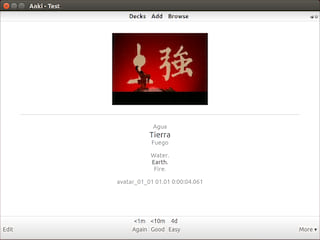19 releases
| 0.5.2 | Mar 13, 2024 |
|---|---|
| 0.4.5 | Dec 8, 2017 |
| 0.4.4 | Nov 23, 2017 |
| 0.4.1 | Mar 18, 2017 |
| 0.0.3 | Dec 26, 2014 |
#366 in Text processing
135KB
3K
SLoC
This is an experimental tool to help language-learners exploit parallel subtitles in various ways. Among other things, it can generate bilingual subtitles, review pages, and decks of Anki cards:


Here's the documentation:
Example usage:
# Create a bilingual subtitle file.
substudy combine episode_01_01.es.srt episode_01_01.en.srt \
> episode_01_01.bilingual.srt
# Export images, audio clips and subtitles as a web page.
substudy export review episode_01_01.mkv \
episode_01_01.es.srt episode_01_01.en.srt
Installing ffmpeg
To use substudy, you'll need to have the ffmpeg command-line tools installed on your system. You can find official packages for most platforms at the FFmpeg site. But here are some instructions for specific
platforms:
# Ubuntu 16.04 and later.
sudo apt update
sudo apt install ffmpeg
# MacOS X with `brew` installed.
brew install ffmpeg
If you're running Windows, or if you're a Mac user who's never heard of brew, then you'll probably want to download your packages from the FFmpeg site. Note that these configurations haven't been tested much, so if you run into problems, please report an issue so that we can fix it.
Installing substudy using binary releases
The easiest way to install substudy is to use an official binary release for your platform. Download the appropriate *.zip file, open it, and install the binary somewhere your operating system can find it. Here are some instructions for common platforms:
# Linux x86_64 and MacOS X.
unzip substudy-*.zip
sudo cp substudy /usr/local/bin
The Linux binaries are statically linked, so they should work on any reaonably modern x86_64 distribution. For other architectures, you might try to install using cargo as described below.
For Windows, you'll have to figure it out yourself for now. But if you do, please file an issue and tell us how you did it, so that we can update the instructions!
Telling your OS it's OK to run substudy
Linux trusts you to run software you download.
Normally, MacOS and Windows want all programs to be signed by a developer. This would cost me money every year ($99/year for MacOS, and around $300–400/year for an EV certificate Windows). You might be able to work around this by following these instructions:
- MacOS: Open an app from an unidentified developer
- OK Windows 10, we get it: You really do not want us to install this unsigned application. But 7 steps borders on ridiculous
Obviously, you should only do this if you trust me, and you should always download the binaries from the official releases page. And if you have up-to-date instructions for how to do this, please file an issue and tell us how you did it.
Installing substudy using cargo
You can also install substudy is using the cargo install command. To use this, you'll need a recent version of Rust. If you already have rustup installed, you can run:
rustup update stable
If you've never heard of rustup, you can look at the instructions on the rustup page, or you can just run the following:
# Mac and Linux only. Windows see above.
curl https://sh.rustup.rs -sSf | sh
Once that is set up, you can then install substudy by running:
cargo install substudy
Building substudy
Assuming you have Rust and the other dependencies installed as described above, you can run:
git clone https://github.com/emk/substudy.git
cd substudy
cargo build
If this fails, please feel free to submit an issue.
Contributing
Please feel welcome to send me a pull request or submit an issue!
Make sure everything continues to work with your changes:
cargo test
Things which I'd love to see substudy support include:
- Creating various sorts of parallel media: subtitles, Anki cards, etc.
- (2017 goal) Automatic vobsub to
*.srtconversion, using OCR and character databases. There are several open source Windows tools which tackle this, but it should be theoretically possible to do a lot better.
Things which I'll probably merge if they come with clean code and solid test suites:
- Better character set conversion.
- Various sorts of subtitle cleanups.
- Formats other than
*.srt. - Better algorithms for repairing timings and alignment.
I'm happy to leave serious, interactive subtitle editing to Subtitle Edit, and to focus on cases related to language learning, and to things which are convenient to call from the command line. I'd also be happy to have implementations of the most useful subs2srs features in command-line form—it's a wonderful and useful program, but it has too many configuration options and it requires too much work using external utilities.
License
This code is distributed under the Apache 2.0 license. Our test suites contain a half-dozen lines of subtitles from copyrighted TV shows, which should presumably fall under de minimis, fair use or equivalent exceptions in most jurisdictions.
Earlier versions of this code were distributed under the CC0 1.0 Universal public domain grant (plus fallback license). This may give you additional rights in certain jurisdictions, but you'd have to check with a legal professional.
Dependencies
~29–44MB
~697K SLoC